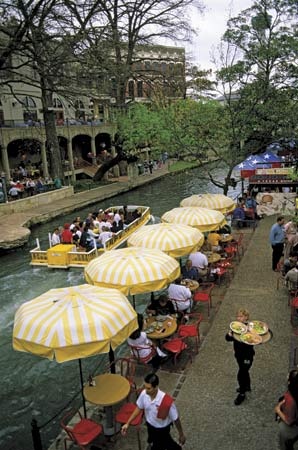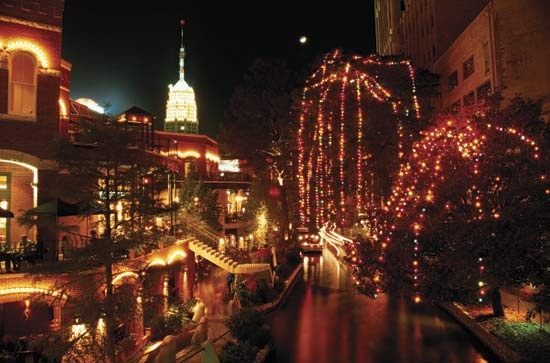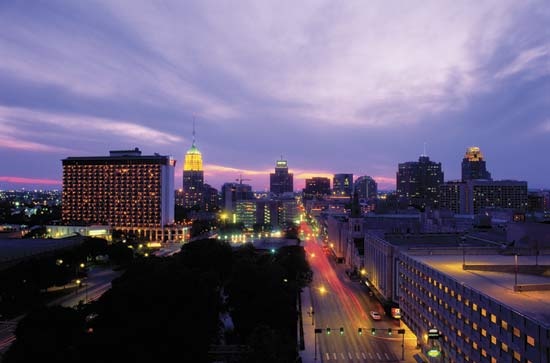San Antonio
Texas, United States
Introduction
 city, seat (1837) of Bexar county, south-central Texas, U.S. It is situated at the headwaters of the San Antonio River on the Balcones Escarpment, about 80 miles (130 km) southwest of Austin. The second most populous city in Texas, it is the focus of a metropolitan area that includes Alamo Heights, Castle Hills, Converse, Kirby, Leon Valley, Live Oak, Schertz, Terrell Hills, Universal City, and Windcrest. Inc. 1809. Area city, 412 square miles (1,067 square km). Pop. (2000) city, 1,144,646; San Antonio MSA, 1,711,703; (2007 est.) city, 1,328,984; San Antonio MSA, 1,990,675.
city, seat (1837) of Bexar county, south-central Texas, U.S. It is situated at the headwaters of the San Antonio River on the Balcones Escarpment, about 80 miles (130 km) southwest of Austin. The second most populous city in Texas, it is the focus of a metropolitan area that includes Alamo Heights, Castle Hills, Converse, Kirby, Leon Valley, Live Oak, Schertz, Terrell Hills, Universal City, and Windcrest. Inc. 1809. Area city, 412 square miles (1,067 square km). Pop. (2000) city, 1,144,646; San Antonio MSA, 1,711,703; (2007 est.) city, 1,328,984; San Antonio MSA, 1,990,675.History
 Spanish explorers first visited the site, then a camp of the Payaya Indians, in 1691. San Antonio was founded May 1, 1718, when a Spanish expedition from Mexico established the Mission San Antonio de Valero. The mission, later called the Alamo (Spanish: “Cottonwood”), was one of five founded in the area and was named for St. Anthony of Padua. On May 5 a presidio (military garrison) known as San Antonio de Béxar was established nearby. The site, on the river's west bank, was a stopping place on the trail through the Texas wilderness between missions on the Rio Grande and those in East Texas.
Spanish explorers first visited the site, then a camp of the Payaya Indians, in 1691. San Antonio was founded May 1, 1718, when a Spanish expedition from Mexico established the Mission San Antonio de Valero. The mission, later called the Alamo (Spanish: “Cottonwood”), was one of five founded in the area and was named for St. Anthony of Padua. On May 5 a presidio (military garrison) known as San Antonio de Béxar was established nearby. The site, on the river's west bank, was a stopping place on the trail through the Texas wilderness between missions on the Rio Grande and those in East Texas.In 1731 settlers from the Canary Islands laid out the town of San Fernando de Béxar near the presidio, where a civilian community had been planned when the presidio and mission were established. During its early years the settlement suffered from raids by Apache and Comanche tribes. The mission was secularized in 1793 and became a military post. San Fernando de Béxar functioned as provincial capital from 1773 to 1824, but in subsequent years its political authority waned. By 1837, when it became a county seat of the Republic of Texas, it had been renamed San Antonio.
At the time of Mexican independence in 1821, San Antonio was, along with Goliad and Nacogdoches, one of three established Spanish communities in Texas. In the summer of that year, Stephen Austin (Austin, Stephen) arrived in the city (then seat of the Spanish government in Texas) to follow through on a permit obtained by his father for the admission of 300 U.S. families into the territory. In December 1835, at the outset of the Texas revolution, Texan forces occupied the Alamo. They remained there until March 1836, when they were massacred by Mexican troops under General Antonio López de Santa Anna (Santa Anna, Antonio López de) following a 13-day siege. The presidio ceased to exist with the independence of Texas in April.
In 1836 San Antonio was still the foremost city of Texas, with some 2,500 inhabitants. It grew rapidly after independence, led by large numbers of German immigrants. During the last decades of the 19th century, San Antonio, as the starting point for the Chisholm Trail, became a major cattle centre, where herds were assembled for the overland drives to the railheads in Kansas.
The city quickly became the commercial hub of the Southwest. The arrival of the first railroad in 1877 brought migrants from the American South, and Mexican immigrants settled there after the start of the Mexican Revolution in 1910. San Antonio was a major military centre during World Wars I and II, a factor that continued to dominate its economy in subsequent decades. In 1968 a world's exposition, known as HemisFair, was held there to commemorate the city's 250th anniversary and to celebrate its cultural ties with Latin America. In 1981 Henry Cisneros was elected the city's first Hispanic mayor since the mid-19th century; Cisneros served until 1989, and in 2001 Ed Garza was elected the city's second modern-era Hispanic mayor.
The contemporary city
 San Antonio's character is a colourful blend of Mexican and Texan culture. It is 150 miles (240 km) from the Mexican border at Laredo, on one of the most traveled routes to Mexico. Much of its population (about three-fifths) is of Hispanic (mainly Mexican) descent, and many are Spanish-speaking or bilingual. It preserves much of its historical atmosphere and embraces its cultural diversity. Remains of 18th-century Spanish structures dot the city, contrasting with modern office buildings.
San Antonio's character is a colourful blend of Mexican and Texan culture. It is 150 miles (240 km) from the Mexican border at Laredo, on one of the most traveled routes to Mexico. Much of its population (about three-fifths) is of Hispanic (mainly Mexican) descent, and many are Spanish-speaking or bilingual. It preserves much of its historical atmosphere and embraces its cultural diversity. Remains of 18th-century Spanish structures dot the city, contrasting with modern office buildings.Military installations largely account for San Antonio's rapid growth after 1940. Fort Sam Houston (1879), inside the city, is the headquarters of the U.S. 5th Army and site of a national cemetery and the Academy of Health Sciences, the army's basic school for medical personnel. Nearby are three U.S. Air Force bases: Lackland, Randolph, and Brooks. Lackland, in the southwestern part of the city, is a training base for recruits. Randolph, in a suburban area to the northeast, is headquarters of the Air Education and Training Command. Brooks, in the southeastern part of the city, is the site of the School of Aerospace Medicine. The region's first air base, Kelly (established 1917), was closed in 2001, and its site was redeveloped for business use.
In addition to the military, major components of San Antonio's economy are education, health care and medical research, business and financial services, and—most importantly—tourism. Manufactures include aerospace equipment, textiles, semiconductors, industrial machinery, and shoes; there are also oil refineries. Agricultural production in the area includes cattle, poultry, peanuts (groundnuts), sorghum, vegetables, and greenhouse plants; the processing of and research on agricultural products is also important. A large portion of trade between Mexico and the United States passes through the San Antonio area's interstate highway system. The city also has an international airport.
San Antonio is the seat of St. Mary's University (1852), Trinity University (1869), University of the Incarnate Word (1881), Our Lady of the Lake University (1896), St. Philip's College (1898), San Antonio College (1925), and the University of Texas (Texas, University of) at San Antonio (1969). A health science centre of the University of Texas is also there.
 The River Walk, or Paseo del Rio, is San Antonio's outdoor centrepiece. Winding through the downtown area, its landscaped banks are lined with shops and restaurants. San Antonio Missions National Historical Park (established 1978) preserves the Spanish missions Nuestra Señora de la Concepción de Acuña, San José y San Miguel de Aguayo, San Juan Capistrano, and San Francisco de la Espada. The park, with a total area of about 1.3 square miles (3.3 square km), is located along the Mission Trail, which begins at the Alamo and extends 9 miles (14 km) along the San Antonio River. Casa Navarro State Historic Site preserves the home (c. 1848) of José Antonio Navarro, a Mexican statesman who supported the independence of Texas. Other historic sites include the famous Alamo (maintained as a state historic site), the reconstructed Spanish Governor's Palace (1749), and La Villita (a section of reconstructed Spanish settlement).
The River Walk, or Paseo del Rio, is San Antonio's outdoor centrepiece. Winding through the downtown area, its landscaped banks are lined with shops and restaurants. San Antonio Missions National Historical Park (established 1978) preserves the Spanish missions Nuestra Señora de la Concepción de Acuña, San José y San Miguel de Aguayo, San Juan Capistrano, and San Francisco de la Espada. The park, with a total area of about 1.3 square miles (3.3 square km), is located along the Mission Trail, which begins at the Alamo and extends 9 miles (14 km) along the San Antonio River. Casa Navarro State Historic Site preserves the home (c. 1848) of José Antonio Navarro, a Mexican statesman who supported the independence of Texas. Other historic sites include the famous Alamo (maintained as a state historic site), the reconstructed Spanish Governor's Palace (1749), and La Villita (a section of reconstructed Spanish settlement).HemisFair Park, the site of the world's fair, is linked to the central city by the River Walk and is used for conventions and exhibitions; the park's Institute of Texan Cultures traces nationalities of Texas, and its Tower of the Americas, 750 feet (229 metres) tall, is a city landmark. San Fernando Cathedral (completed 1873) is the seat of a Roman Catholic archbishopric. The Marion Koogler McNay Art Museum contains a notable collection of modern French paintings, and the Witte Museum houses Texas artifacts. The San Antonio Museum of Art has a collection of Latin American art, and the Museo Alameda, which is affiliated with the Smithsonian Institution, is dedicated to Latin American culture. The city also has dozens of music, dance, and theatre organizations, including a professional symphony. SeaWorld (SeaWorld, Inc.) San Antonio includes amusement rides and animal shows as well as marine animal exhibits. The Alamodome (1993) is the site of conventions and concerts and the home of the city's professional basketball team, the Spurs. The San Antonio Zoo (San Antonio Zoological Gardens and Aquarium), which includes an aquarium, is a popular attraction. Annual events include a rodeo (February), Fiesta San Antonio (April), and the Texas Folklife Festival (June).
- Doris
- Doris Day
- Doris Humphrey
- Doris Kearns Goodwin
- Doris Lessing
- Doris Ulmann
- Dorking
- dormancy
- dormer
- dormouse
- Dornberger, Walter Robert
- Dornbirn
- Dorner, Isaak August
- Dornier, Claudius
- Dorothea Jordan
- Dorothea Lambert Chambers
- Dorothea Lange
- Dorothea Lynde Dix
- Dorotheus
- Dorothy Alexander
- Dorothy Annie Elizabeth Garrod
- Dorothy Arzner
- Dorothy Canfield Fisher
- Dorothy Constance Stratton
- Dorothy Crowfoot Hodgkin